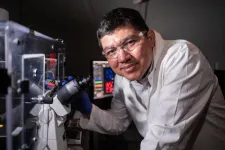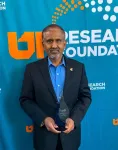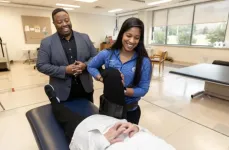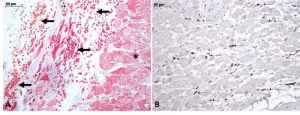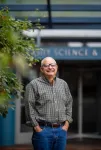(Press-News.org) Heart rates are easier to monitor today than ever before. Thanks to smartwatches that can sense a pulse, all it takes is a quick flip of the wrist to check your heart. But monitoring the cells responsible for heart rate is much more challenging — and it’s encouraged researchers to invent new ways to analyze them.
Joseph Wu, M.D., Ph.D., director of the Stanford Cardiovascular Institute and professor of medicine and of radiology, has devised a new stem cell-derived model of heart tissue that provides insight into conditions that crop up when heart cells beat out of control. In particular, Wu is studying a disorder called tachycardia, which increases the heart rate and can lead to cardiomyopathy, in which the heart loses its ability to pump blood sufficiently in people with otherwise healthy heart structures.
“Tachycardia is probably more common than we think,” said postdoctoral scholar Chengyi Tu, Ph.D., who helped lead the work. “It’s believed to be underdiagnosed because an increase in heart rate is quite common in different types of heart diseases, and it gets masked.”
To study tachycardia-induced cardiomyopathy, the researchers engineered heart cells from human stem cells to uncover how our body’s engine runs when it’s in overdrive.
“Modeling tachycardia-induced cardiomyopathy with human stem cell-derived heart tissues allows us to better understand the impact of fast heart rates on our bodies,” said Wu, the Simon H. Stertzer, M.D., Professor who is the senior author of the study. It was published Nov. 27 in Nature Biomedical Engineering. Tu is the lead author.
Engineering heart cells
Unlike most types of organ tissues, heart cells are extremely difficult to grow in a lab. Patient heart cells cultured in a dish tend to de-differentiate –– or lose their primary function and fail to beat.
“Ideally, you want to take samples of a patient’s heart just after disease diagnosis, during illness and after treatment,” Tu said. “To validate your discovery, you need a lot of replicates to give you statistical power, but clinically, it’s impossible to sample so frequently.”
Given the dearth of tissue, Wu and his colleagues grew more than 400 heart tissue samples from stem cells to look at how heart cells function, a process that spanned more than four years.
“Making engineered heart tissue is very different from culturing cells in a dish. The timeline is very long,” Tu said. Generating heart cells from stem cells takes about two weeks; putting them together in a 3D tissue and maturing them takes almost two months.
Restoring the chemical balance
Using a wired chamber, the researchers electrically stimulated the cells, inducing tachycardia. They tested whether the cells could recover from tachycardia over the course of 10 days. During the first five days, the cells’ ability to contract continuously declined to about 50% of normal function. But once the researchers stopped the electrical stimulation, the cells made a full recovery in five days.
That tracks with what doctors already know about tachycardia-induced cardiomyopathy — it’s mostly reversible. When a person’s heart rate slows back down, their heart tissue function returns to normal.
In another experiment, researchers induced tachycardia in a different group of engineered heart tissue. Then, after stopping stimulation, the team supplemented the tissues with NAD –– a molecule that supports energy reactions –– and saw the heart cells’ function recover more rapidly. The supplemented tissues had recovered 83% of their original function by the first day, while the untreated group showed little improvement.
To validate their findings, the team compared the engineered heart tissues with clinical human data and canine model data. “I was surprised by how well the engineered heart tissues mimic the real human hearts,” Tu said.
Uncovering the molecular switch
During tachycardia, the heart may struggle to pump blood to the rest of the body because the fast heart rate prevents the heart’s chambers from filling up and contracting fully. If it persists for several days or weeks, which can happen in severe cases, blood vessels stop supplying enough oxygen to the heart tissue and the rest of the body.
When beating normally, the heart uses fat as an energy source, but breaking down fats requires a lot of oxygen. Without oxygen, the heart’s fuel source switches to sugar in a process called metabolic rewiring. The fuel switch and hypoxia, or lack of oxygen, contribute to a decrease in the NAD/NADH ratio, a vital chemical duo that helps maintain the function of a protein in heart tissue known as SERCA.
“Varying levels of the SERCA protein act like a gas and brake pedal for a car,” Tu said. When researchers increase the amount of NAD, the heart’s gas pedal is thrusted, and the SERCA protein strengthens the heartbeat of the engineered cells. When decreased, the engineered heart tissues hit the brakes, making them beat more weakly.
By giving patients NAD through an off-the-shelf supplement or by IV injection, clinicians believe they can restore the chemical balance and accelerate a patient’s recovery.
Alongside a new possible supplement to help patients recover from tachycardia, the research demonstrates the importance of new methods to model disease. Last year, President Joe Biden signed the FDA Modernization Act 2.0 into law, which removed the requirement for animal testing before human drug trials. “Now, there is more need for non-animal models to complement the animal models,” Tu said. “This work proves that it’s possible to model complex cardiac conditions using a universal non-animal model to study this disease and test possible therapeutics.”
This study was funded by the American Heart Association, the National Institutes of Health (grants K99 HL164962, K01 HL130608, R01 HL151345, R01 HL163680, R01 HL141371, R01 HL113006, R01 HL150693 and P01 HL141084), and the National Aeronautics and Space Administration.
END
Engineered human heart tissue shows Stanford Medicine researchers the mechanics of tachycardia
Researchers engineered stem cell-derived heart tissues to study how tachycardia affects the heart and to uncover the inner workings of our body’s engine
2023-12-19
ELSE PRESS RELEASES FROM THIS DATE:
Molecular jackhammers’ ‘good vibrations’ eradicate cancer cells
2023-12-19
The Beach Boys’ iconic hit single “Good Vibrations” takes on a whole new layer of meaning thanks to a recent discovery by Rice University scientists and collaborators, who have uncovered a way to destroy cancer cells by using the ability of some molecules to vibrate strongly when stimulated by light.
The researchers found that the atoms of a small dye molecule used for medical imaging can vibrate in unison ⎯ forming what is known as a plasmon ⎯ when stimulated by near-infrared light, causing the cell membrane of cancerous cells to rupture. ...
Nearly 30% of caregivers for severe stroke survivors experience psychological distress
2023-12-19
Stroke is an abrupt, devastating disease that instantly changes a person’s life and has the potentially to cause lasting disability or death. However, the condition also has profound effects on the patient’s loved ones — who are often called to make difficult decisions quickly.
A new study led by Michigan Medicine finds that nearly 30% of caregivers of severe stroke patients experience high levels of anxiety, depression or post-traumatic stress during the first year after the patient leaves the hospital.
The results are published in Neurology.
“As physicians, we usually concentrate on our ...
MSU research suggests pandas are active posters on ‘social media’
2023-12-19
MSU has a satellite uplink/LTN TV studio and Comrex line for radio interviews upon request.
Images
Pandas, long portrayed as solitary creatures, do hang with family and friends — and they’re big users of “social media.” Scent-marking trees serve as a panda version of Facebook.
An article in the international journal Ursus paints a new lifestyle picture of the beloved bears in China’s Wolong National Nature Reserve, a life that’s shielded from human eyes because they’re shy, rare and live in densely forested, remote areas. No one really knows how pandas hang, but a new study indicates pandas are around others more than previously thought. ...
UTHSC, Vanderbilt University receive $2.4 million grant to promote diversity in speech-language pathologists for high-need children
2023-12-19
The Department of Audiology and Speech Pathology at the University of Tennessee Health Science Center and the Department of Hearing and Speech Sciences at Vanderbilt University have secured a $2,399,454 grant to fund a five-year project to address the need for diversity in highly trained professionals in speech-language pathology.
The project, known as Project PAL (Preparing Academic Leaders in Speech-Language Pathology to Teach, Conduct Research, and Engage in Professional Service to Improve Outcomes for Children with High Need Communication Disorders), ...
American University receives $5.7 million from NSF to bridge research and policy, address real-world challenges
2023-12-19
American University won a $5.7 million cooperative research agreement from the U.S. National Science Foundation’s Accelerating Research Translation program. The award will help AU foster greater use of evidence in the public and private sectors by producing new knowledge on best practices in research translation, training scholars in the effective conduct of research translation, and supporting the dissemination of research findings that have the potential to benefit society.
The ART program ...
UTRF Innovation Awards celebrate UTHSC researchers
2023-12-19
The University of Tennessee Research Foundation (UTRF) celebrated the researchers whose achievements are making life better locally, nationally, and globally at its annual Innovation Awards ceremony, held December 14 at the Mooney Library at the University of Tennessee Health Science Center (UTHSC) in Memphis.
The Innovation Awards recognize researchers from all over the UT System who partner with UTRF to bring their innovations to market. “Turning research into practical, sustainable solutions calls for resilience, adaptability, and market savvy. Let's collectively celebrate the foundational research successes that made ...
Groundbreaking hip-focused physical therapy reduces low back pain
2023-12-19
When the University of Delaware’s Gregory Hicks started his research career two decades ago, he was one of only a few people in the United States studying chronic low back pain in people over 60 years old.
Fast-forward to today, the research on back pain has ramped up, yet studies of older adults with the problem are still sparse.
“Unfortunately, the societal attitude is that older people don’t warrant the same level of care that younger people do when it comes to musculoskeletal problems,” said Hicks, Distinguished Professor of Health Sciences at UD. “But I don’t believe that for a ...
Researchers report detailed analysis of heart injury caused by yellow fever virus
2023-12-19
To fill gaps in knowledge of yellow fever (YF), a group of researchers in Brazil affiliated with the Department of Pathology at the University of São Paulo’s Medical School (FM-USP), Hospital das Clínicas (HC, the hospital complex run by FM-USP), the Heart Institute (InCor, linked to HC) and Emílio Ribas Institute of Infectious Diseases (IIER) decided to study the pathogenesis of YF-associated heart injury.
The team was led by Fernando Rabioglio Giugni, a cardiologist, and Amaro Nunes Duarte-Neto, an infectious disease specialist and pathologist; both work at FM-USP.
“There’s still no specific treatment for yellow fever. Patients receive ...
David Kaplan named fellow of the National Academy of Inventors
2023-12-19
David Kaplan, the Stern Family Endowed Professor of Engineering, has been named a fellow of the National Academy of Inventors (NAI). Election as an academy fellow is the highest professional distinction awarded solely to inventors. The NAI was founded to recognize and encourage inventors with U.S. patents and enhance the visibility of academic technology and innovation.
As a member of the Class of 2023, Kaplan will be honored at the NAI’s annual meeting on June 18, 2024 in Raleigh, North ...
Research spotlight: Structural analysis and inhibition of human LINE-1 ORF2 protein reveals novel adaptations and functions
2023-12-19
Martin Taylor, MD, PhD, a physician investigator in the Department of Pathology at Massachusetts General Hospital and an instructor in Pathology at Harvard Medical School, is the lead corresponding author of a new study in Nature, Structural Analysis and Inhibition of Human LINE-1 ORF2 Protein Reveals Novel Adaptations and Functions.
What Question Were You Investigating?
About a fifth of the human genome is half a million copies of a transposon, a virus-like element known as LINE-1 (L1). L1 was ignored as “junk DNA” for years but is increasingly recognized to contribute to the pathology of autoimmunity, ...
LAST 30 PRESS RELEASES:
B cells transiently unlock their plasticity, risking lymphoma development
Advanced AI dodel predicts spoken language outcomes in deaf children after cochlear implants
Multimodal imaging-based cerebral blood flow prediction model development in simulated microgravity
Accelerated streaming subgraph matching framework is faster, more robust, and scalable
Gestational diabetes rose every year in the US since 2016
OHSU researchers find breast cancer drug boosts leukemia treatment
Fear and medical misinformation regarding risk of progression or recurrence among patients with breast cancer
Glucagonlike peptide-1 receptor agonists and asthma risk in adolescents with obesity
Reviving dormant immunity: Millimeter waves reprogram the immunosuppressive microenvironment to potentiate immunotherapy without obvious side effects
Safety decision-making for autonomous vehicles integrating passenger physiological states by fNIRS
Fires could emit more air pollution than previously estimated
A new way to map how cells choose their fate
Numbers in our sights affect how we perceive space
SIMJ announces global collaborative book project in commemoration of its 75th anniversary
Air pollution exposure and birth weight
Obstructive sleep apnea risk and mental health conditions among older adults
How talking slows eye movements behind the wheel
The Ceramic Society of Japan’s Oxoate Ceramics Research Association launches new international book project
Heart-brain connection: international study reveals the role of the vagus nerve in keeping the heart young
Researchers identify Rb1 as a predictive biomarker for a new therapeutic strategy in some breast cancers
Survey reveals ethical gaps slowing AI adoption in pediatric surgery
Stimulant ADHD medications work differently than thought
AI overestimates how smart people are, according to HSE economists
HSE researchers create genome-wide map of quadruplexes
Scientists boost cell "powerhouses" to burn more calories
Automatic label checking: The missing step in making reliable medical AI
Low daily alcohol intake linked to 50% heightened mouth cancer risk in India
American Meteorological Society announces Rick Spinrad as 2026 President-Elect
Biomass-based carbon capture spotlighted in newly released global climate webinar recording
Illuminating invisible nano pollutants: advanced bioimaging tracks the full journey of emerging nanoscale contaminants in living systems
[Press-News.org] Engineered human heart tissue shows Stanford Medicine researchers the mechanics of tachycardiaResearchers engineered stem cell-derived heart tissues to study how tachycardia affects the heart and to uncover the inner workings of our body’s engine
